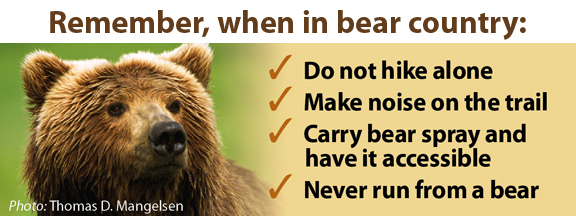The SLRD is bear country. Bears are active from spring thaw, typically in March, through to December. However, contrary to popular belief, some black bears may not hibernate if they are able to find non-natural food sources. It is important to be aware and alert for bear encounters.
Do your part to reduce human-bear conflicts with these 8 Steps to Be Bear Smart at Home and learn more about how to Be Bear Smart out on the Trails.
AT HOME
Bears are attracted to our communities because of one major driving force – hunger. Non-natural food sources like garbage and fruit trees are the main attractants and bears will return to readily available food sources. On average, over 900 black bears across BC are killed each year a result of human bear conflict.
We all play a role in the reducing human-bear conflict by managing attractants and ensuring wildlife can safely move through communities without being attracted to non-natural food sources.
8 Steps to Be Bear Smart at Home:
- ALWAYS keep garbage and recycling in bear-resistant totes and in a secured building.
- In areas with curbside pick-up, be sure to only put your tote on the curb the morning of your collection day, AND remove it from the curb at the end of the day and store it inside a secured building until your next collection day.
- Wash all recycling items and regularly clean garbage and recycling totes.
- Wrap smelling items in newspaper and freeze until disposal.
- Burn off grease from BBQ’s and clean out grease traps after each use.
- Prune fruit trees over the winter and pick fruit and berries before fully ripe.
- Report bear sightings to allow for early interventions by calling the Conservation Officer Service: 1-877-952-7277
- Report unsecured attractants to the appropriate local authority. Click here for details.
ON THE TRAILS
The key to staying safe on the trails and in the back country is to avoid surprise encounters and respecting the environment.
- Make noise by using your voice i.e. talk, sing, or give a shout out when approaching a blind corner, near rivers, or near natural bear food.
- Riding or running quickly and quietly puts you at a higher risk for surprise encounters. Slow down going around blind corners and make noise.
- Look for signs of recent bear activity i.e. claw marks on trees, fresh scat, day beds, ripped apart logs or overturned boulders.
- Hike in groups.
- Be extra aware during the early morning and early evening hours.
- Leash dogs.
- Pack out what you pack in.
If you encounter a bear:
- Stop, stay calm and assess the situation
- Do not run
- Never turn your back on wildlife
- Back away slowly and give the bear space
- Talk calmly
- Avoid eye contact
- Ready your deterrent

Always report wildlife sightings or injured wildlife and/or encounters to the BC Conservation Officer Service 24-hotline at 1-877-952-7277 (RAPP) or online at www.rapp.bc.ca

View the WildSafe BC sightings map
(Sources: WildSafe BC, District of Squamish, Get Bear Smart Society Whistler, BC Minisitry of the Environment)
